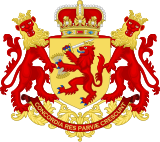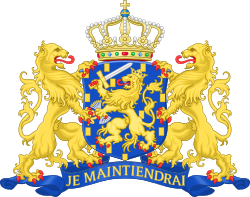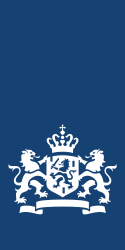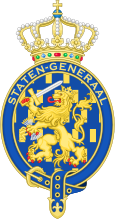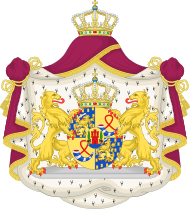Coat of arms of the netherlands
Coat of Arms of the Kingdom of the Netherlands, it is also the personal crest of the Dutch monarch. It contains the same elements from August 24, 1815, when William I (first King of the Netherlands), chose a combination of the old coat of arms of the House of Nassau and the coat of arms of the United Provinces of the Netherlands.
Currently the coat of arms is described by the Royal Decree of April 23, 1980, which has not introduced any modifications.
The text of the Royal Decree that regulates the coat of arms of the Netherlands is as follows:
- Article 1: The coat of arms of the Kingdom of the Netherlands, as well as the one of Our successors, the Kings of the Netherlands is azur, sown with gold notes, with a golden lion crowned with the same, lamped and armed with gules, carrying on the right hand a silver sword with a hilt of gold and in the sinister claw a bundle of seven silver arrows,
- Article 2: The shield carries the following outer ornaments: to top the shield, the Royal Dutch crown; to hold the shield, two lions of gold, flaxed and nails of gules; and the motto “Je maintiendrai” (I'll keep it.) in gold letters on a sugar tape.
- Article 3: The shield described in Article 1, provided with its outer ornaments, can be placed on a royal purple mantle, gold-plated and lined with armor, mounted with golden strings that end up in embroidery of the same metal and crowned with a purple baldaquin, golden ribbed on which the royal crown rests.
Origin and evolution of the coat of arms of the Netherlands
Since 1815, few changes have been made to the coat of arms of the Netherlands. The last modification, beyond issues related to the design, was made on July 10, 1907 when the crowned guarding lions (the name given in heraldry to lions depicted looking at the observer) that supported the shield were replaced by others that looked straight ahead and did not wear crowns.
As indicated, William I, the first monarch of the Netherlands, adopted arms in which he combined elements of the heraldry of his lineage with those of the coat of arms of the United Provinces of the Netherlands (1581-1795). The coat of arms of the House of Nassau had the following heraldic description: In a field of azure strewn with gold bills, a rampant lion of the same (a lion resting on two of its legs, yellow in color on a blue background decorated with yellow pieces). The elements that Guillermo I introduced in his arms came from the shield used by the States General of the Republic of the United Provinces. It is about the sword and the bunch or bundle of seven arrows (one for each province) that the lion holds in its right and left claws respectively.
Heraldry of the Counts of Nassau
The coat of arms of the House of Nassau dates from around 1250. A few years later the lineage's heraldry adopted two variants corresponding to its two main branches. One of these branches descends from Count Walram II of Nassau and another from Count Otto I of Nassau, both sons of Count Henry II (ca. 1190-1251). The ruling dynasty in the Netherlands belongs to the line of Count Otto I and the Grand Dukes of Luxembourg are descendants of Count Walram.
Walram's line represented the lion on his crowned shield to differentiate himself from the other family branch. In relation to the exterior adornments, in the armories of the House of Nassau the heraldic helmet has only appeared in the ring of shields belonging to its male members. In the heraldry of the descendants of Otto I, the helmet appeared placed under a crown and a crest in the shape of two extended wings of saber (black color), adorned with arched bands of silver (white color) and decorated with various leaves. These elements were joined by lambrequins (a heraldic ornament of the doorbell) with the colors of the Nassau armories, azur and gold (blue and yellow).). The descendants of Earl Walram used a different crest that had a seated golden lion as its central element.
In the decree of 1815, together with a closed royal crown, the use of the helmet as a heraldic stamp of the monarch of the Netherlands was regulated. In this decree, the crest that belonged to the Walram branch was established instead of that of the Ottonian line, which was the one that corresponded to William I by lineage. The reason for this decision could not be clarified, probably a mistake could have been made. Some male members of the Royal House of the Netherlands have continued to use the helmet and crest of Walram's line on their shields.
Heraldry of the Princes of Orange
The motto of the Nassau lineage, since it took control of the Principality of Orange in 1530, has been "Je Maintiendrai", which in Spanish means & #34;I will keep". Count Henry III of Nassau-Breda married Claudia de Châlons, who was the sister of Filiberto de Chalôns, the last prince of Orange who belonged to the House of Châlons. When Filibert died in 1530 without issue, he was succeeded by a son of Count Henry III and Claudia de Châlons, René de Nassau-Breda. He inherited the principality, but was forced to keep Châlons as the name of the lineage and to continue using the coat of arms of this family. This is the reason why this prince has gone down in history as René de Châlons.
The phrase "Je Maintiendrai Châlons", adopted as its motto by the House of Nassau, expresses Count René's commitment to his uncle's inheritance. René died in 1544 childless and his niece, William of Nassau-Dillenburg (known as William the Silent), became his heir. William founded the House of Orange-Nassau and became known as William of Orange. Initially William the Silent substituted the motto "Je Maintiendrai Châlons" by "Je Maintiendrai Nassau". Later, Guillermo or one of his heirs withdrew the name of the lineage from the motto, and it was reduced to & # 34; Je Maintiendrai & # 34;.
Cornets, one of the central elements of the Châlons' heraldry, were not incorporated into the shields of the monarchs of the Netherlands belonging to the House of Orange-Nassau, but can be seen on the royal banner and on the variants used by members of the Royal Family.
Seal and coat of arms of the Seven United Provinces
In the heraldry of the Republic of the United Provinces, a gold rampant lion could be seen carrying a sword and a bunch or bundle of arrows in its front claws. These elements were already used in the times when they were a domain of the House of Austria.
The rampant lion, as a symbol of the Burgundian Netherlands, began to be used as the crest of Philip the Fair's shield and the sword was introduced during the reign of his son Charles I. The Seventeen Provinces continued to use these symbols throughout the century XVI. In 1578, during the Eighty Years' War, the States General of the Provinces adopted a seal depicting the figure of a rampant lion armed with a sword and seventeen arrows, one for each province, despite the fact that only seven of these gained their independence from the Spanish branch of the House of Austria. The seal of the States General was used until the year 1795.
Since 1584, the Republic of the Seven United Provinces had a shield whose emblazonment was: In a field of gold, a lion rampant of gold, armed, languished in azure and crowned with gold, holding a sword in its right hand and in his left a bundle of azure arrows. The colors chosen were those most used in the coat of arms of Holland, the most important province (which in turn was the one used by the counts of Holland since a date close to the year 1198).
Around 1668 the field of the coat of arms became gules (heraldic red) and the lion began to appear crowned in gold, armed and lavished with azure. It was also established that the sword was represented silver with a golden hilt and the arrows silver with golden tips. >.
1795-1815: Revolution, Napoleonic Period, and Restoration
In 1795, due to a French intervention, William V of Orange, the last stadtholder, was overthrown and fled to England, proclaiming the Batavian Republic which lasted until 1806.
The Batavian Republic adopted as its emblem an allegory of Dutch freedom (with the characteristic female figure) accompanied by a lion. In 1806 the Kingdom of Holland was created with Louis Bonaparte, Napoleon's brother, as monarch. Luis Bonaparte used a quartered shield in which the coat of arms of the Seven United Provinces were combined with the Napoleonic eagle. In this shield the lion carried for the first time a closed royal crown.
In the year 1813, when the French were expelled from the Netherlands, the last stadtholder's son, William VI of Orange, was proclaimed Sovereign Prince. Guillermo took the opportunity to adopt a new coat of arms. In the coat of arms itself, the Napoleonic eagle that appeared on Louis Napoleon's coat of arms was replaced by the Châlon and Orange coats of arms. The Nassau coat of arms was placed on an escutcheon, located in the center of the shield.
With the establishment of the United Kingdom of the Netherlands in 1815, with Orange-Nassau as the ruling dynasty, the Seven United Provinces and the Austrian Netherlands were unified into a single country. Its first monarch, William I of Orange (until then William VI) decided that the royal arms should be modified again and it was decided to combine the shields of the United Provinces and the reigning dynasty making the lion that appeared in the latter carry the sword and the bundle of arrows with which the other of the coat of arms of the United Provinces was armed.
Abbreviated versions and variants of the coat of arms of the Netherlands
Version used by the Government
The government of the Netherlands, its diplomatic missions, consulates, and other government institutions use a simplified version of the royal arms that does not include the mantle, canopy, and the royal crown that rests on the canopy. This shield is also the one that appears represented in Dutch passports.
|
Other institutional versions
|
Variants worn by members of the Royal Family
Contenido relacionado
Birds
Knesset
Phoenicia



